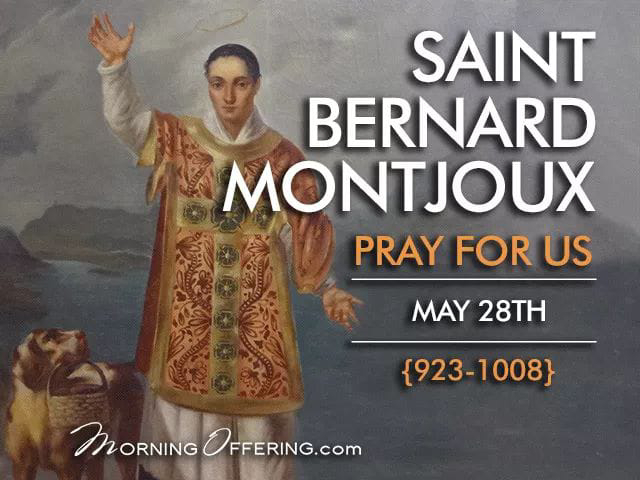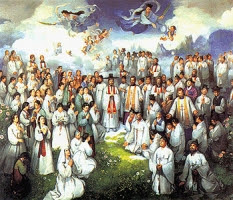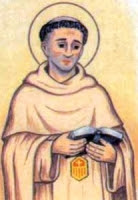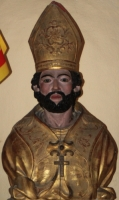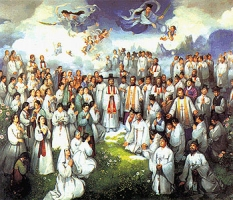St. Senator
Feastday: May 28
Death: 480
Archbishop of Milan, Italy, and papal legate. While still a priest, he was sent by Pope St. Leo I the Great as a legate to the imperial court of Constantinople (modern Istanbul, Turkey) to petition Emperor Theodosius II to summon a council to define Chrisfs two natures in the wake of the heresies of the time. Senator was subsequently sent as a papal representative to the Council of Chalcedon (451), which proved a triumph for orthodoxy and the position of the pope. In 472, Senator was appointed archbishop of Milan.
St. Bernard of Montjoux
மான்ட்ஜூக்ஸ் நகர புனிதர் பெர்னார்ட்
(St. Bernard of Montjoux)
இத்தாலிய துறவி, மறைப்பணியாளர், புகழ்பெற்ற (Hospice) எனப்படும் நல்வாழ்வு சேவை மையம் மற்றும் மடத்தின் நிறுவனர்:
(Italian monk, Religious, and the Founder of the famed Hospice and Monastery)
பிறப்பு: கி.பி 1020
சேட்டோ டி மெந்தன், சவோய் கவுண்டி, ஆர்லஸ் இராச்சியம்
(Château de Menthon, County of Savoy, Kingdom of Arles)
இறப்பு: ஜூன் 1081
நோவாரா இம்பீரியல் சுதந்திர நகரம், தூய ரோமானியப் பேரரசு
(The Imperial Free City of Novara, Holy Roman Empire)
ஏற்கும் சமயம்:
கத்தோலிக்க திருச்சபை (Catholic Church)
(புனித அகஸ்டினின் சபை உறுப்பினர்கள்) (Canons Regular of St. Augustine)
கிழக்கு மரபுவழி திருச்சபை
(Eastern Orthodox Church)
புனிதர் பட்டம்: கி.பி 1681
திருத்தந்தை பதினோராம் இன்னசென்ட்
(Pope Innocent XI)
நினைவுத் திருநாள்: மே 28
பாதுகாவல்:
மலையேறுபவர்கள், பனிச்சறுக்கு, பனிச்சறுக்குப் பலகை, மலையேறுபவர்கள் பின்னால் சுமக்கும் சுமை மற்றும் ஆல்ப்ஸ் மலை
மான்ட்ஜூக்ஸ் நகர புனிதர் பெர்னார்ட், ஒரு இத்தாலிய துறவியும், மறைப்பணியாளருமாவார். இவர், (Hospice) எனப்படும் புகழ்பெற்ற நல்வாழ்வு மையம் மற்றும் துறவு மடத்தின் நிறுவனரும் ஆவார். இது, கிட்டத்தட்ட ஆயிரம் ஆண்டு காலமாக, மேற்கு ஆல்ப்ஸ் மலைத்தொடரின் மிகவும் ஆபத்தான பகுதிகளில் அடைக்கலமாகும் மலையேறும் பயணிகளை மீட்கும் பணி சேவை செய்திருக்கிறது. இவர்களது மீட்புப் பணி முழுதுமே, இவர்களது சபையினராலேயே செய்யப்பட்டு வந்துள்ளது. குளிர்கால புயல்களின் போது மீட்புப் பணிக்காக இவர் வளர்த்துவந்த புகழ்பெற்ற ஒருவகை இன நாய்கள், இவற்றின் சிறப்புக்காகவே, இவரது பெயராலேயே - "புனித பெர்னார்ட் நாய்கள்" (St. Bernard dogs) என்று அழைக்கப்படுகின்றன.
அக்கால "ஆர்லெஸ்" (Kingdom of Arles) இராச்சியத்தின் ஒரு பகுதியான "கௌன்டி சவோய்" (County of Savoy) எனப்படும் தூய ரோம மாநிலத்தின் "சேட்டோ டி மெந்தன்" (Château de Menthon) எனும் நகரில் பிறந்த பெர்னார்ட், ஒரு பணக்கார மற்றும் உன்னத குடும்பத்திலிருந்து வந்தவர் ஆவார். பாரிஸ் (Paris) நகரில் தமது முழுமையான கல்வியைப் பெற்றார். அவர் இளமைப் பருவத்தை அடைந்ததும், திருச்சபையின் சேவைக்காக தன்னை அர்ப்பணிக்க முடிவுசெய்தார். தனது தந்தை ஏற்பாடு செய்த கெளரவமான திருமணத்தை மறுத்துவிட்டார்.
(பிரபலமான புராணக்கதை ஓன்று, இவருக்கு ஏற்பாடு செய்யப்பட்ட திருமணத்திற்கு முந்தைய இரவில் அவர் கோட்டையிலிருந்து வெளியேறினார் என்றும், ஜன்னலிலிருந்து தன்னைத் தூக்கி எறிந்து, தரையிலிருந்து சுமார் 40 அடி உயரத்தில் கோட்டையிலிருந்து பறக்கும்போது, தேவதூதர்களால் பிடிக்கப்பட்டு மெதுவாக, பாதுகாப்பாக இறக்கப்பட்டதாகவும் கூறப்படுகிறது.
இத்தாலிய ஆல்ப்ஸ் மலைகளில் (Italian Alps) உள்ள இருமொழிப் பகுதியான "ஆஸ்டா பள்ளத்தாக்கின்" (Aosta Valley) "ஆஸ்டா" (Aosta) நகரின் தலைமை திருத்தொண்டரான (Archdeacon of Aosta) "பீட்டரின்" (Peter) வழிகாட்டுதலின் கீழ் தன்னை நிலைநிறுத்திக் கொண்டார். அவருடைய வழிகாட்டுதலின் கீழ் அவர் வேகமாக முன்னேறினார். ஒரு குருவாக அருட்பொழிவு செய்யப்பட்ட பெர்னார்ட், மலை கிராமங்களில் மிஷனரியாக பணியாற்றினார். பின்னர், அவரது கற்றல் மற்றும் நல்லொழுக்கம் காரணமாக, அவர் தனது ஆலய தலைமை திருத்தொண்டராக நியமிக்கப்பட்டார். அவருக்கு நேரடியாக ஆயரின் கீழே, மறைமாவட்டத்தின் அதிகார பொறுப்புகளை வழங்கினர்.
42 ஆண்டுகளாக, அவர் தொடர்ந்து இந்த மக்களுக்கு நற்செய்தியைப் பிரசங்கித்தார். இத்தாலியின் வடமேற்குப் பிராந்தியமான லோம்பார்டியின் பல மண்டலங்களுக்குள் கூட, ஏராளமான மாற்றங்களைச் செய்தார். மற்றும் பல அற்புதங்களையும் செய்தார். புனித பெர்னார்ட்டின் வாழ்க்கையின் கடைசி செயல் இரண்டு பிரபுக்களின் இடையே இருந்த வேற்றுமைகளை அகற்றிச் சமரச நல்லிணக்கமாகும். அவர்களிடையே இருந்த சண்டை ஒரு அபாயகரமான அச்சுறுத்தியதலை விளைவிக்கக் கூடியதாய் இருந்தது.
அவர் கி.பி. 1081ம் ஆண்டு, ஜூன் மாதம், நோவாரா இம்பீரியல் சுதந்திர நகரில் இறந்தார். புனித லாரன்ஸ் மடத்தில் அடக்கம் செய்யப்பட்டார்.
நியூயார்க் (New York) நகர "சரனாக்" (Saranac Lake) ஏரியில் உள்ள புனித பெர்னார்ட் கத்தோலிக்க தேவாலயம் (Saint Bernard's Catholic Church) அவரது பெயரில் அர்ப்பணிக்கப்பட்டதாகும்.
Feastday: May 28
Patron: of mountaineers, skiers, the Alps
Birth: 923
Death: 1008
Author and Publisher - Catholic Online
Bernard of Montjoux was probably born in Italy. He became a priest, was made Vicar General of Aosta, and spent more than four decades doing missionary work in the Alps. He built schools and churches in the diocese but is especially remembered for two Alpine hospices he built to aid lost travelers in the mountain passes named Great and Little Bernard, after him. The men who ran them in time became Augustinian canons regular and built a monastery. The Order continued into the twentieth century. He was proclaimed the patron saint of Alpinists and mountain climbers by Pope Pius XI in 1923. He is sometimes fallaciously referred to as Bernard of Menthon and the son of Count Richard of Menthon, which he was not. His feast day is May 28th.
Bernard became patron and protector of skiers because of his four decades spent in missionary work throughout the Alps.
Bernard of Menthon (Italian: San Bernardo di Mentone; Latin: Bernardus; German: Bernhard) was a canon regular and founder of the Great St Bernard Hospice,[1] as well as its associated Canons Regular of the Hospitaller Congregation of Great Saint Bernard.[2] He gave his name to the Saint Bernard breed of dog, originally bred for the cold environment of the hospice.
Blessed Maria Bagnesi
Also known as
• Bartholomaea Bagnesi
• Maria Bartolomea Bagnesi
• Marietta Bagnesi
• Mary-Bartholomew Bagnesi
Profile
A happy, beautiful, under-sized, frequently neglected child, her mother often left her to the care of others, including a sister who was a Dominican nun. Marietta grew up and had her best times in her sister's convent, and four of her sisters eventually entered religious life.
When her father arranged a marriage for Maria, she actually fainted in horror. The thought of marriage made her so sick that she eventually became unable to walk, and was bed-ridden. Her father, a man easily swayed by quacks, crack-pots and con men, put her through 34 years of flummery and what passed for medical treatment in the 16th century.
Being bed-ridden, Maria was not able to follow her sisters into the convent, but she did become a Dominican tertiary in 1544. She made her formal profession in 1545, and was soon able to get out of bed for brief periods. However, a combination of pleurisy, asthma, kidney disease, and the non-stop "treatments" she received from assorted quacks and cranks immobilized her again. She began to have visions, and to converse with angels, devils and saints. Her neighbors thought she was possessed, but a local priest became her spiritual advisor, and reassured the locals that Marietta was not in league with the devil or being attacked by him.
With the priest's assurances, Marietta's room became a place for area pilgrims who came to her for wisdom and peace, and for area animals, especially cats. Cats had a special affection for her, many stayed in her room, slept on her bed, guarded her pet songbirds, and at least once fetched her some cheese when she became hungry.
Maria developed a deep devotion to Saint Bartholomew the Apostle, and added his name to hers. As her visions and ecstacies continued and became more constant, she became more mystical in her conversation, became focused on the glorious and sorrowful mysteries, and was seen to levitate. She came to know Saint Mary Magdalen of Pazzi, and shared her visions with her.
Born
15 August 1514 at Florence, Italy
Died
28 May 1577 at Florence, Italy of natural causes
Beatified
11 July 1804 by Pope Pius VII (cultus confirmed)
Patronage
• abuse victims
• against the death of parents
• sick people
Blessed Iuliu Hossu
Profile
The son of Ioan Hossu and Victoria Mariutiu. He studied at the Seminary of Cluj, Romania, the seminary of Budapest, Hungary, the University of Vienna, Austria, and the Pontifical Urbanian Athenaeum “De Propaganda Fide,” Rome, Italy. He earned a doctorate in philosophy in 1906, and one in theology in 1908. Ordained a priest in the archdiocese of Fagaras si Alba Iulia, Romania on 27 March 1910; the ordination was performed by his uncle, Bishop Vasile Hossu. From 1911 to 1914 he served variously as protocolist, archivist, librarian, vicar-general and secretary to the bishop of Gherla, Romania. Military chaplain to the Romanian soldiers in the Austro-Hungarian Army during World War I from 1914 to 1917. Chosen Bishop of Cluj-Gherla, Romania by Pope Benedict XV on 21 April 1917. Apostolic Administrator of Maramures, Romania from 19 July 1930 till 31 January 1931. Apostolic Administrator of Oradea Mare, Romania from 29 August 1941 till 1947. For opposing the state-ordered separation of Byzantine-Rumanian Church from Rome, he was imprisoned in prisons in the Romanian cities of Jilava, Drogoslavele, Sighet, and Gherla from 1948 till 1964, and then at the monastery of Caldrusani in Moara Saraca near Bucharest, Romania from 1964 until his health began to fail in 1970 when he was moved to hospital. Secretlu elevated to cardinal by Pope Paul VI on 28 April 1969, but to prevent additional abuse, this was was not revealed until after the Cardinals‘ death. Martyr.
Born
30 January 1885 in Milas, Bistrita-Nasaud, archdiocese of Fagaras e Alba Julia, Romania
Died
• 9 a.m. on 28 May 1970 at Coletina Hospital in Bucharest, Romania
• buried in the Bellu Catholic Cemetery, Bucharest
• re-interred in his permanent tomb in the the same cemetery on 7 December 1982
Beatified
2 June 2019 by Pope Francis
Blessed Luigi Biraghi
Profile
The fifth of eight children. Entered the Minor Seminary of Castello sopra Lecco, Italy at age 12; studied in the Major Seminaries of Monza and Milan in Italy. Ordained in the archdiocese of Milan, Italy on 28 May 1825. Taught in the seminaries of Castello sopra Lecco, Seveso and Monza. A highly educated and cultured man with deep knowledge of the early Church fathers and archeology. Spiritual director of the Major Seminary of Milan in 1833.
With the help of Mother Mariana Videmari, in 1836 Father Biraghi founded the Institute of the Sisters of Saint Marcellina (Marcellina Sisters) at Cernusco sul Naviglio; the Institute requires fidelity to the faith in daily life by its members, and established schools for girls, both the nobility who could pay for it, and the poor who were not required. Named a doctor of the prestigious Biblioteca Ambrosiana in 1855. Honorary canon of the Basilica of Saint Ambrose. In 1862, by the Pope's request, he acted as mediator among the clergy of Milan who were split between those who supported a united Italy, and those who sought the return of the Papal States. Vice-Prefect of the Ambrosiana in 1864. Appointed Domestic Prelate to Blessed Pope Pius IX in 1873. Today the Marcellina Sisters continue their good work in Italy, France, Brazil, Switzerland, England, Albania, Canada, and Mexico.
Born
2 November 1801 in Vignate, Milan, Italy
Died
• 11 August 1879 in Milan, Italy of natural causes
• buried in the family grave in Cernusco sul Naviglio, Italy
• relics translated to the chapel of the mother-house of the Marcellina Sisters in Cernusco in 1951
Beatified
• 30 April 2006 by Pope Benedict XVI
• recognition celebrated in Milan, Italy
Blessed Antoni Julian Nowowiejski
Also known as
Antonio Giuliano Nowowiejski
Additional Memorial
12 June as one of the 108 Polish Martyrs of World War II
Profile
Antoni studied at the seminary of Plock, Poland, and was ordained a priest on 10 July 1881 in Plock. Professor and rector of the Plock seminary. Vicar-General of Plock in 1902. Bishop of Plock on 12 June 1908. Titular Archbishop of Silyum on 25 November 1930. Known for his deep spiritual and prayer life, he was an historian, active pastor of his people, and supported religious and Bible study groups.
In his 80's, Bishop Antoni was imprisoned with a a group of his priests during the Nazi occupation of Poland in World War II. He was taken from prison to prison, and finally ended in the Dzialdowo concentration camp. As he was leader among the prisoners, especially the imprisoned clergy, he was tortured repeatedly, and the guards worked hard to humiliate him and break his spirit; Bishop Antoni responded by blessing them. Martyr.
Born
11 February 1858 in Lubien, Poland
Died
• died of starvation and abuse on 28 May 1941 at Dzialdowo death camp, occupied Poland
• buried in an unmarked grave somewhere near the camp
Beatified
13 June 1999 by Pope John Paul II at Warsaw, Poland
Blessed Margaret Pole
Also known as
Margaret Plantaganet
Profile
Daughter of the Duke of Clarence. Niece of King Edward IV and King Richard III of England. Married Sir Richard Pole in 1491. Mother of five, one of whom became a cardinal. Widow. Unofficial ward of King Henry VIII, who made her Countess of Salisbury and governess to Princess Mary, daughter of Henry VIII.
When she opposed Henry's plan to marry Ann Boleyn, she was driven from court and received the king's disfavor. When her son, Cardinal Reginald Pole, wrote against Henry's presumptions to spiritual supremacy, the king decided to crush the family. Two of Margaret's sons were executed in 1538 for the crime of being the brothers of Reginald. The elderly Margaret was arrested soon after, falsley charged with plotting revolution; in 1539 she was sent to the Tower of London where she spent her remaining two years. In 1541, at the outbreak of an actual uprising, Margaret was summarily executed with trial as a precaution. Martyr.
Born
14 August 1473 in Somerset, Wilshire, England as Margaret Plantaganet
Died
• beheaded 28 May 1541 on Tower Hill, London, England
• buried at Saint Peter ad Vincula, Tower of London
Beatified
29 December 1886 by Pope Leo XIII (cultus confirmation)
Blessed Lanfranc of Canterbury
Profile
After a liberal education in England, he went to Normandy and entered the monastery at Bec, where he opened a famous school. An opponent of the doctrines of Berengarius, he succeeded in having the Catholic doctrine defined at the Lateran Council of 1059. He obtained the papal dispensation for the marriage of William, Duke of Normandy, to Matilda of Flanders, and after William's invasion of England in 1066, Lanfranc was made Archbishop of Canterbury. He secured the primacy of the See of Canterbury over that of York, helped reform the Church in Scotland, and prevented many ruptures between the king and pope over the question of tithes. In the struggle over investitures, he consistently upheld the rights of the Church. Lanfranc probably advised the king to name William Rufus his successor, and he subsequently made constant efforts to check the evil deeds of the latter.
Born
c.1005 in Pavia, Italy
Died
• 24 May 1089 in Canterbury, England of natural causes
• interred under the Saint Martin altar at the Canterbury cathedral
Blessed Herculaneum of Piegaro
Also known as
• Herculaneum of Pieghèro
• Ercolano, Herculan, Herculanus
Profile
Franciscan friar minor. Spiritual student of Blessed Albert of Sarteano. Ordained a priest in the early 15th century, Herculaneum became a sought after travelling preacher known for his austerity, his long fasts, and as a miracle worker. While he was preaching in the cathedral of Lucca, Italy during Lent of 1430, the city came under seige by the army of Florence, Italy; Herculaneum rallied the people of Lucca, found ways to smuggle food into the city, and helped them keep their faith until the siege ended; the people of Lucca gave him the Pozzuolo convent in thanks and to insure he returned. Sent by the papal legate to preach missions in the east from 1435 to 1437.
Born
late 14th-century at Piegaro, Italy
Died
• summer of 1451 in the convent of Castelnuovo, Garfagnana, Tuscany, Italy of natural causes
• exhumed in 1456 and found incorrupt
• relics enshrined in the church of the convent of Castelnuovo
Beatified
29 March 1860 by Pope Pius IX (cultus confirmation)
Saint Phaolô Hanh
Also known as
Paul Hanh
Additional Memorial
24 November as one of the Martyrs of Vietnam
Profile
Born to a Christian family in the apostolic vicariate of West Cochinchina (in modern Vietnam), Paul and two of his brothers joined a band of highwaymen and burglars, with Paul as their leader. When Paul insisted that the thieves return some of their loot to the poor, they betrayed him to the authorities, accusing him of treason by collaborating with the French. Arrested, Paul denied the treason but proclaimed himself a sinful Christian and refused to renounce his faith. Tortured and martyred in the persecutions of emperor Tu-Duc.
Born
c.1826 in Cho Quán, Gia Dinh, Vietnam
Died
• beheaded on 28 May 1859 at Saigon (modern Ho Chi Minh City), Vietnam
• buried in the cemetery at Cho Quán, Gia Dinh, Vietnam
Beatified
2 May 1909 by Pope Pius X as part of the Annamite Martyrs
Canonized
19 June 1988 by Pope John Paul II
Saint William of Gellone
Also known as
• William of Aquitaine
• William of Orange
• William of Toulouse
• Willliam Fierabrace
• William in the Desert
• Guillaume...
• Marquis au court nez
Profile
Born to the nobility, the son of Aldana and Count Thierry of Toulouse. Career soldier. Member of the court of Blessed Charlemagne. Duke of Aquitaine. Led forces against the Saracens in southern France. In retirement he built a monastery at Gellone, France, and became a Benedictine monk there; the house was later named Saint-Guilhem-du-Desert in his honour. His reputation for chivalry, bravery and piety led to medieval romances being written about him including the Chançun de Guillaume (Song of William).
Born
755 in France
Died
812 of natural causes in the monastery that was later re-named Saint William in the Desert in his honour
Canonized
1066 by Pope Alexander II
Saint Germanus of Paris
பாரிஸ் நகர் புனிதர் ஜெர்மாய்ன்
(St. Germain of Paris)
பாரிஸ் மறைமாவட்ட ஆயர்/ ஏழைகளின் தந்தை:
(Bishop of Paris/ Father of the Poor)
பிறப்பு: கி.பி. 496
அவுடன், ஃபிரான்ஸ்
(Autun, France)
இறப்பு: மே 28, 576
பாரிஸ், ஃபிரான்ஸ்
(Paris, France)
ஏற்கும் சமயம்:
ரோமன் கத்தோலிக்க திருச்சபை
(Roman Catholic Church)
கிழக்கு மரபுவழி திருச்சபை
(Eastern Orthodox Church)
புனிதர் பட்டம்: கி.பி. 754
திருத்தந்தை இரண்டாம் ஸ்டீஃபன்
(Pope Stephen II)
நினைவுத் திருநாள்: மே 28
புனிதர் ஜெர்மாய்ன், பாரிஸ் மறை மாவட்ட ஆயரும் (Bishop of Paris) "ஏழைகளின் தந்தை" (Father of the Poor) என அறியப்படுபவரும் ஆவார்.
ஃபிரான்ஸ் நாட்டின் "அவுடன்" (Autun) என்ற இடத்தினருகே வசதியுள்ள "கல்லோ-ரோமன்" (Gallo-Roman) இன பெற்றோருக்குப் பிறந்த ஜெர்மாய்ன், "பர்கண்டியிலுள்ள" "அவல்லான்" (Avallon in Burgundy) என்ற இடத்தில் கல்வி கற்றார்.
தமது 35 வயதில் புனிதர் "அக்ரிப்பினா" (Saint Agrippina of Autun) என்பவரால் குருத்துவ அருட்பொழிவு செய்விக்கப்பட்டார். பின்னர், அருகாமையிலுள்ள "புனிதர் சிம்போரியன்" (Abbey of St. Symphorian) துறவு மடத்தின் மடாதிபதியானார்.
கி.பி. 555ம் ஆண்டு, பாரிஸ் நகரின் ஆயர் "சிபெலியஸ்" (Sibelius, the Bishop of Paris) இறந்துவிடவே, அரசர் "முதலாம் சில்டேபர்ட்" (Childebert I) ஜெர்மாய்னை ஆயராக தேர்ந்தெடுத்து அருட்பொழிவு செய்வித்தார்.
ஆயர் ஜெர்மாய்ன் அவர்களின் ஆலோசனைகளாலும், செல்வாக்கினாலும் அரச குடும்பமே ஒரு சிறப்பான சீர்திருத்த வாழ்க்கை வாழ்ந்தது. அரசவையில் பணியாற்றியபோதும், எளிமையையும், துறவு வாழ்வையும் ஒருபோதும் எக்காரணத்தை முன்னிட்டும் கைவிடவில்லை. தன்னுடைய ஒறுத்தல் வாழ்வினாலும், அருமையான, எளிமையான மறையுரையாலும் மக்களை இறைவன்பால் ஈர்த்தார். இவரது மறையுரையைக் கேட்கவே மக்கள் கூடி வந்து, காத்திருந்தனர்.
566ம் ஆண்டு, "டூர்ஸ்" நகரில் நடந்த கிறிஸ்தவ மாநாட்டில் (Second Council of Tours) பங்குபெற்றார். கி.பி. 557ம் ஆண்டு முதல் கி.பி. 573ம் ஆண்டு வரை பாரிஸ் நகரில் நடந்த மூன்றாம் மற்றும் நான்காம் மாநாடுகளிலும் (Third and Fourth Councils of Paris) கலந்துகொண்டார். "கௌல்" (Gaul) மாநிலத்தில் வழக்கத்திலிருந்த பாகனிய பழக்கங்களை முறித்துக் கொள்ளும்படி அரசனை அவர் தூண்டினார். பெரும்பாலான கிறிஸ்தவ திருவிழாக்களுடன் பாகன் கொண்டாட்டங்களைச் சேர்த்துக் கொள்ளும் அதிகாரம் தடைசெய்யப்பட்டது.
ஆயர் ஜெர்மாய்ன் கி.பி. 576ம் ஆண்டு, பாரிஸ் நகரில் மரித்தார்.
Also known as
• Father of the Poor
• Germain
Profile
Priest, ordained by Saint Agrippinus of Autun. Abbot. Bishop of Paris, France in 555. Taught and ordained Saint Bertrand of Le Mans. Spiritual teacher of Saint Droctoveus. Cured King Childebert I from an unnamed illness, and converted him from a misspent life. The king then built him the abbey of Saint Vincent, now known as Saint-Germain-des-Pres.
Born
496 at Autun, France
Died
• 28 May 576 in Paris, France of natural causes
• interred in a decorated tomb in the chapel of Saint Symphorien next to the abbey church c.635
• relics re-shrined to the church in 754 by order of King Pepin the Short
Canonized
754 by Pope Stephen II
Patronage
archdiocese of Rimouski, Quebec
Blessed Wladyslaw Demski
Also known as
• Ladislao Demski
• Ladislaus Demski
Additional Memorial
12 June as one of the 108 Martyrs of World War II
Profile
A professor of classical languages, he became a priest in the archdiocese of Gniezno, Poland, serving in the parish of the Blessed Virgin Mary church in Inowroclaw, Poland. Arrested by occupying Nazi forces on 2 November 1939, he was sent to the Sachsenhausen concentration camp where he was abused, tortured, and finally murdered for refusing to trample his rosary when ordered to do so by camp guards. Martyr.
Born
5 August 1884 in Sztum, Pomorskie, Poland
Died
tortured to death on 28 May 1940 in the concentration camp at Sachsenhausen-Oranienburg, Oberhavel, Germany
Beatified
13 June 1999 by Pope John Paul II
Saint Caraunus of Chartres
Also known as
Carauno, Ceraunus, Cheron
Additional Memorial
18 October (translation of relics)
Profile
When his parents died, Caraunus sold all his goods and estate, distributed the money to the poor, and retired from the world to live as a prayerful hermit. His reputation for holiness spread, his local bishop ordained Caraunus as a deacon, and the new deacon gave up the life of a hermit to serve as a missionary to areas of Gaul where the faith had all but disappeared.
Born
Gaul
Died
• killed by robbers near Chartres, France in the 5th century
• a church and monastery were later built over his tomb
• his relics were hidden to prevent their destruction during the anti–Christian persecutions of the French Revolution
• relics enshrined in the church of Saint Caraunus in Chartres
Blessed John Shert
Additional Memorials
• 29 October as one of the Martyrs of Douai
• 1 December as one of the Martyrs of Oxford University
Profile
Educated at Brasenose College, Oxford, England graduating in 1566. Schoolmaster in London, England. Convert to Catholicism. Servant to Dr Thomas Stapleton at Douai, France. Studied at Douai, and at Rome, Italy. Ordained in 1576 at the English College at Rome. Returned to England on 27 August 1579 to minster to covert Catholics. Arrested for the crime of being a priest, and sent to the Tower of London on 14 July 1581. Martyr.
Born
at Shert Hall, near Macclesfield, Cheshire, England
Died
hanged, drawn, and quartered on 28 May 1582 at Tyburn, London, England
Beatified
29 December 1886 by Pope Leo XIII (cultus confirmation)
Blessed Thomas Ford
Profile
Received a Master of Arts at Trinity College, Oxford, England on 14 July 1567. Fellow of Trinity College. Left to study at the English College, Douai, France in 1570. Ordained in March 1573 at Brussels, Belgium. Returned to the apostolic vicariate of England on 2 May 1576. Chaplain to Edward Yates and the Bridgettins at Lyford, Berkshire. Arrested on 17 July 1581, he was imprisoned and tortured in the Tower of London, accused and tried for treason as part of a non-existent conspiracy of Catholics against the crown, and executed in the persecutions of Queen Elizabeth I. Martyr.
Born
Devon, Devonshire, England
Died
hanged on 28 May 1582 in Tyburn, London, England
Beatified
29 December 1886 by Pope Leo XIII
Saint Ubaldesca Taccini
Profile
An only child born to a poor but pious family, she was early drawn to religious life and the care of people even poorer than herself. Joining the Order of Saint John of Jerusalem at age 15, she lived a nun‘s life for 55 years. Had the gift of miraculously healing.
Born
1136 in Calcinaia, Pisa, Italy
Died
• feast of the Holy Trinity, 28 May 1206 in Pisa, Italy of natural causes
• miraculous healings reported at her tomb
• some relics translated to Malta on 30 June 1587
Beatified
Pope Sixtus V granted a plenary indulgence to those who visit her relics in Malta on 28 May
Blessed Robert Johnson
Additional Memorial
29 October as one of the Martyrs of Douai
Profile
Studied at Rheims, France, and Rome, Italy. Ordained at Douai, France in 1576. He then returned to England to minister to covert Catholics in the London area. Arrested in 1580 in connection with the non-existent Rheims and Rome Plot. Imprisoned in the Tower of London. Tried and convicted with Saint Edmund Campion and others. Martyr.
Born
in Shropshire, England
Died
hanged, drawn and quartered on 28 May 1582 at Tyburn, London, England
Beatified
29 December 1886 by Pope Leo XIII (cultus confirmation)
Blessed Mary of the Nativity
Also known as
Anna de Corro
Profile
In her youth, Anna made a private vow, consecrating herself to God. She joined the Mercedarians at the monastery of the Assumption in Seville, Spain, taking the name Sister Mary of the Nativity. Known for her deep contemplative prayer life, she received visions of heaven, and spent her time in praise of God. People throughout the region flocked to the convent to have her pray for them.
Died
1580 at the convent of the Assumption in Seville, Spain
Saint Luciano of Cagliari
Also known as
Feliciano
Additional Memorial
10 March (discovery of his relics)
Profile
Convert, baptized by Saint Peter the Apostle. Spiritual student of Saint Paul the Apostle. Martyr.
Born
Sardinia
Died
• stabbed with a spear on 28 May 69
• relics enshrined in the sanctuary of the cathedral of Cagliari, Italy
Saint Heliconis of Thessalonica
Also known as
Eliconide, Helicondes, Heliconides
Profile
Tortured, mutilated and martyred in the persecutions of Decius for refusing to worship idols.
Born
at Thessalonica
Died
• beheaded c.250 at Corinth, Greece
• legend says that milk, not blood, poured from the wound
Blessed Lluís Berenguer Moratona
Profile
Vincentian priest. Martyred in the Spanish Civil War.
Born
5 July 1869 in Santa Maria d'Horta, Barcelona, Spain
Died
28 May 1937 in Barcelona, Spain
Venerated
1 December 2016 by Pope Francis (decree of martyrdom)
Blessed Albert of Csanád
Profile
Member of the Ordo Fratrum Sancti Pauli Primi Eremita (Order of Friars of Saint Paul the First Hermit) in 15th century Hungary. Noted speaker. Wrote poetry in Latin.
Died
c.1492 at the monastery of Bjacs, Hungary of natural causes
Saint Eoghan the Sage
Also known as
• Eoghan Sapiens
• Eoghan the Wise
• Eoghan of Cranfield
• Eoghan of Cremhcaille
• Magh-Creainb-Chaille
• Ernan, Eunt, Eugenius, Enny, Eugene, Owen
Profile
No reliable information has survived.
Saint Eugene of Armagh
Also known as
• Eoghan
• Fear-leighinn
• Lector of Monastrboice
Profile
Monk. Abbot of Armagh, Ireland. Abbot of Clonard, Ireland.
Born
8th century Ireland
Died
834 in Ireland of natural causes
Saint Caraunus the Deacon
Also known as
Cheron
Profile
Convert during the 1st century. Deacon. Missionary to Gaul. Martyred in the persecutions of Domitian.
Born
Rome, Italy
Died
98 near Chartres in modern France
Saint Justus of Urgell
Also known as
Giusto
Profile
First bishop of Urgell, Spain. Wrote a commentary on the Song of Songs.
Died
c.527
Saint Gemiliano of Cagliari
Also known as
Emily, Emilio, Emiliano, Millanu
Profile
First century bishop of Cagliari, Italy. Martyred in the persecutions of Nero.
Saint Podius of Florence
Profile
Priest. Bishop of Florence, Italy in 990.
Born
Tuscany, Italy
Died
1002 of natural causes
Saint Moel-Odhran of Iona
Also known as
Maelodran, Mailodranus
Profile
7th century monk of Iona, Scotland.
Saint Dioscorides of Rome
Profile
Martyr.
Died
burned to death c.244 in Rome, Italy
Saint Helladius of Rome
Profile
Martyr.
Died
burned to death c.244 in Rome, Italy
Saint Crescens of Rome
Profile
Martyr.
Died
burned to death c.244 in Rome, Italy
Saint Paulus of Rome
Profile
Martyr.
Died
burned to death c.244 in Rome, Italy
Saint Accidia
Profile
Martyred in Africa.
Martyrs of Palestine
Profile
A group of early 5th century monks in Palestine who were martyred by invading Arabs.
Martyrs of Sardinia
Profile
A group of early Christians for whom a church on Sardinia is dedicated; they were probably martyrs, but no information about them has survived except the names Aemilian, Aemilius, Emilius, Felix, Lucian and Priamus.
Patronage
diocese of Alghero-Bosa, Italy
